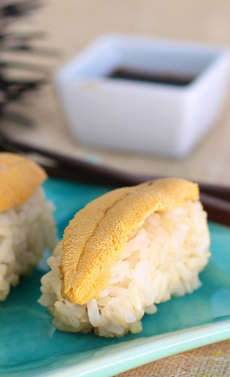TIP OF THE DAY: Sea Urchin
|
Today’s tip is sea urchin: beyond the sushi bar. It was inspired by a story in this month’s Smithsonian Magazine.
At the sushi bar, we always order an uni sushi or two. If they were less pricey, we would toss down half a dozen. Uni is the Japanese word for sea urchin, an ancient shellfish, found worldwide. In the U.S., sea urchins are harvested in the oceans off California, Florida and Maine. They’re expensive to gather, and the price is passed along. More than a few of the world’s sea urchin sites have been overfished. But in the waters off of Norway lie a king’s ransom of sea urchin. Evidently, Norwegians are not as fond of sea urchin as we are, and until Roderick Sloan began to develop a trade among Europe’s fine restaurants, they had no market. Once cursed as a pest by lobstermen, they were routinely smashed with hammers and tossed overboard. Sloan, a 44-year-old émigré Scot, lives 88 miles north of the Arctic Circle, outside the town of Nordskot (population 55). It’s one of Norway’s darkest, bleakest, most remote coastal villages. He is the only full-time sea urchin diver in Norway, with one employee to tend the boat. Sloan dons scuba equipment and swims down to depths of 50 feet, diving among treacherous waves and gutsy squalls. The local species, called Norwegian greens (for the hue of the shell—the binomial name is Strongylocentrotus droebachiensis), are at their prime from November to the end of February (imagine how cold the water is!). |
Sea urchin, fresh from the sea. Photo courtesy I Love Blue Sea. |
|
|
More than 100,000 tons of the delicacy are consumed a year worldwide. France and Japan are big consumers; the Japanese exchange urchins as gifts during New Year celebrations. In the center of the hard shell is a row of five roe or coral (sometimes called tongues), which are the gonads of both males and females. Exotic, briny and grainy, the meat has nuances of iodine and metal and a custardlike, pillowy consistency. Uni is a love-it-or-hate-it food. Of the 800 species of sea urchin, some are much more palatable than others. As a sea urchin lover, we are chagrined that the flavor of expensive sushi bar uni can be wildly inconsistent. It is based on gender, season, terroir and even the particular seaweed the animal eats. When all the factors are united, uni are celestial. At other times, they are as are as bland and disappointing as a mealy apple. |
||
|
|
HOW TO ENJOY SEA URCHIN
Here are culinary ideas from around the world for how to enjoy sea urchin: Here’s an interesting surf and turf: raw sea urchin wrapped in roast beef. Just as it sounds, wrap a thin slice of roast beef around a raw sea urchin or two; lay on a bed of boiled spinach and serve with ponzu (a combination of soy sauce, vinegar and citrus juice). |
|
|
For a delightful hors d’oeuvre or first course, make uni toast: Spread crostini with quality unsalted butter and uni, garnished with scallions and a sprinkling of sea salt. Uni burrata combines creamy burrata cheese with with the briny flavor of uni, then sides it with button mushrooms and yuzu for balance. Here are some sea urchin recipes. Sea urchins, sometimes called sea hedgehogs (for their protruding spiny needles) and krakebolle, “crow’s balls,” in Norwegian, are among the earliest known forms of life. The fossil record dates back some 450 million years. The creatures can be found in almost every major marine habitat from the poles to the Equator, and from shallow inlets to ocean depths of more than 17,000 feet. Sea urchins “look like squash balls encased in pine thistles” according to Franz Lidz, who wrote the Smithsonian article (you can read it in full here). The shell is round and spiny, typically from 1.2 to 3.9 inches in diameter. The colors vary: black, blue, brown, green, olive, purple, red. The animals lack brains. Sea urchins have hundreds of adhesive tube feet and move slowly over the sandy sea floor pursuing a diet of kelp. They are members of the botanical class Echinoidea, and are cousins of sand dollars (there are some 950 species of echinoids, and 800 species of sea urchins). And the pricey critters will no doubt get pricier. The French and Irish exhausted their resident stocks of sea urchin years ago. In Maine, Nova Scotia and Japan, urchin populations have been drastically reduced by overfishing and disease. They are not always welcome: The colonies can be destructive. Off the coasts of California and Tasmania, overfishing of the animal’s natural predators and large-scale change in ocean circulation (believed to be an effect of climate change) have turned vast stretches of the sea floor into moonscape-like “urchin barrens.” The urchins multiply, chew down the kelp and devastate marine ecosystems. No doubt, those species are not among the tasty species, or divers would appear to reap the wealth on the ocean floor.
|
||




